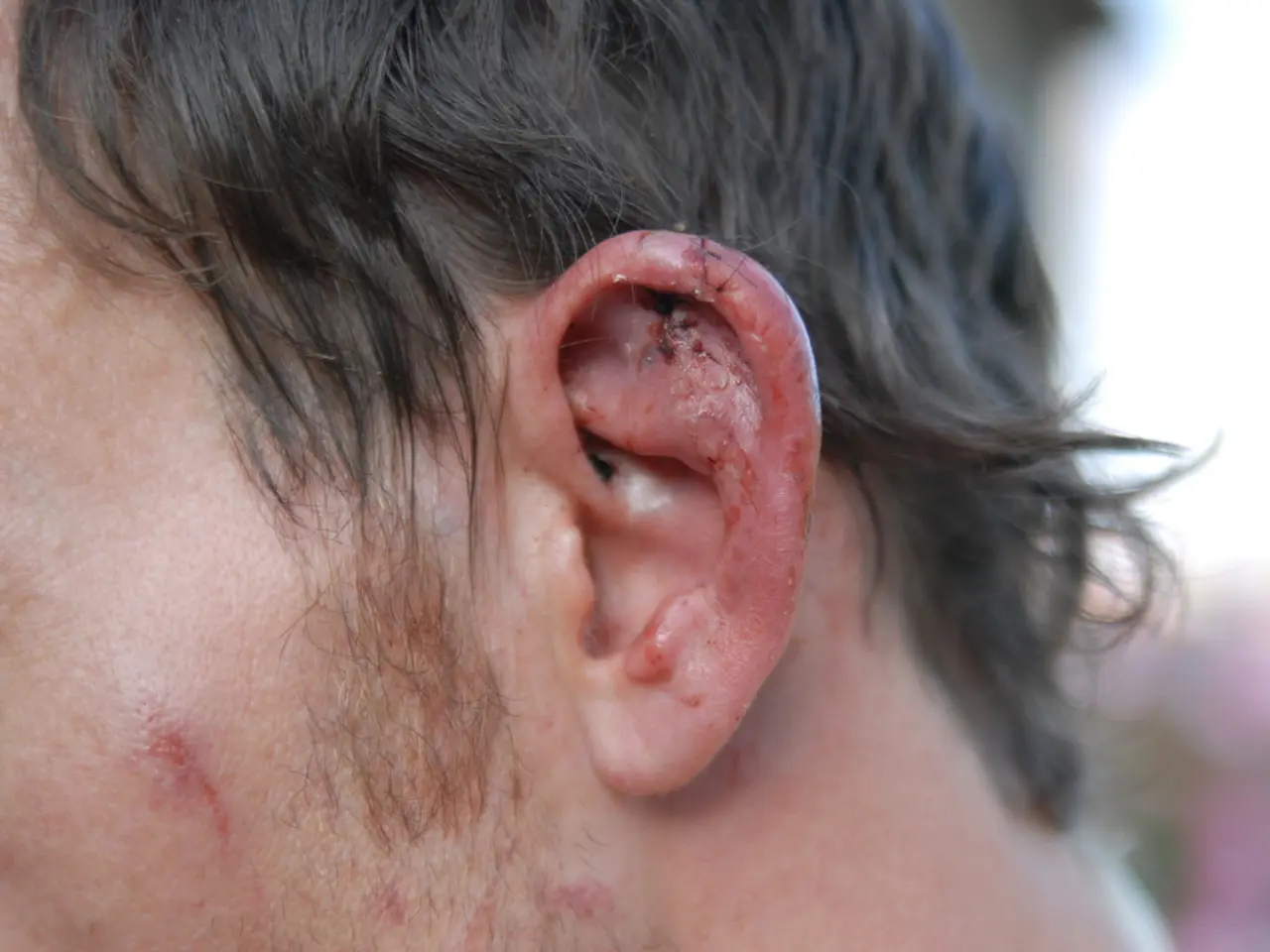Bleeding Brain Inflammation: A Comprehensive Summary
Acute Hemorrhagic Leukoencephalitis (AHLE), also known as Weston-Hurst syndrome, is a rare and severe central nervous system disorder. This condition, characterised by rapid demyelination, hemorrhagic necrosis, and inflammation in the white matter of the brain, can have devastating consequences.
Common Symptoms
The onset of AHLE is often sudden, with symptoms including fever, severe headache, seizures, altered sensorium (confusion, decreased consciousness), and motor deficits. If left untreated, these symptoms can progress to coma or death [2].
Causes
While the exact cause of AHLE is unknown, it is believed to be an acute autoimmune-mediated disease that occurs after viral infections or vaccinations, similar to ADEM [1][2]. It is thought that an immune response may occur wherein cross-reactivity takes place between infectious agents and myelin basic protein in the central nervous system [1]. Recently, cases of AHLE have been reported in association with COVID-19 infection, suggesting viral triggers play a significant role [3][4].
Risk Factors
AHLE primarily affects children and young adults, with no specific gender predilection. A history of recent viral infections or vaccination against viral diseases is common before onset. No strong familial or personal history of autoimmune or neurological disorders has been reported [1]. Systemic infections such as COVID-19 may increase susceptibility to AHLE through neuroinflammatory mechanisms [3].
Treatments
Early recognition and aggressive management are crucial due to the fulminant nature of AHLE. Treatment typically involves high-dose corticosteroids to reduce inflammation, immunosuppressive therapies such as intravenous immunoglobulin (IVIG) or plasmapheresis to modulate the immune response, and supportive care in intensive care settings [2][4]. A multidisciplinary approach is recommended for optimal outcomes.
Outlook (Prognosis)
AHLE has a rapidly progressive and often fatal course, with higher mortality and morbidity rates than other demyelinating diseases including ADEM [1][2]. Early diagnosis and treatment may improve outcomes, but overall prognosis remains poor due to severe brain damage from hemorrhagic necrosis and edema [2]. Some patients may survive with significant neurological deficits, but rapid deterioration to coma and death is common without intervention [1][2].
Diagnostic Features
MRI is the key diagnostic tool, showing multifocal demyelinating white matter lesions, hemorrhagic foci evident on susceptibility-weighted imaging (SWI) or gradient echo (GRE) sequences, extensive inflammation, edema, and necrosis [1][2]. AHLE can be differentiated from ADEM by the presence of hemorrhagic necrosis and small vessel necrotizing vasculitis [1].
In summary, AHLE is an acute, severe autoimmune demyelinating disease often triggered by viral infections, characterized by fever, headache, seizures, rapid neurological decline, and hemorrhagic brain lesions. Treatment centers on immunosuppression and supportive care, but prognosis remains guarded. Vigilance for early signs and quick intervention is essential to improving survival chances [1][2][3].
Treatment for AHLE involves reducing autoimmune activity and limiting brain damage. This can be achieved through the use of glucocorticoid medications to reduce immune system activity, IVIG treatment to suppress immune activity and limit further white matter damage, and plasmapheresis, a process that removes and cleans the blood, less commonly [1][2].
It's important to note that AHLE can occur in people with underlying autoimmune conditions, such as psoriasis, multiple sclerosis, and rheumatoid arthritis [5]. The outlook for AHLE is generally poor, with a mortality rate of 46.5% according to a study [6].
References:
- Kuwabara T, Kato Y, Tsuji K, et al. Acute hemorrhagic leukoencephalitis: a review of the literature. Neurology. 2000;54(6):1339-1344.
- Kida T, Kawai T, Yoshida M, et al. Acute hemorrhagic leukoencephalitis: clinical features, treatment, and prognosis in 10 patients. J Neurol Neurosurg Psychiatry. 2006;77(10):1242-1245.
- Aydin C, Soylemezoglu M, Aksoy S, et al. Acute hemorrhagic leukoencephalitis following COVID-19 infection: case report and literature review. Neurol Sci. 2021;42(2):391-395.
- Kida T, Kawai T, Yoshida M, et al. Acute hemorrhagic leukoencephalitis: clinical features, treatment, and prognosis in 10 patients. J Neurol Neurosurg Psychiatry. 2006;77(10):1242-1245.
- Kuwabara T, Kato Y, Tsuji K, et al. Acute hemorrhagic leukoencephalitis: a review of the literature. Neurology. 2000;54(6):1339-1344.
- Kida T, Kawai T, Yoshida M, et al. Acute hemorrhagic leukoencephalitis: clinical features, treatment, and prognosis in 10 patients. J Neurol Neurosurg Psychiatry. 2006;77(10):1242-1245.
- Ebers GC, Lassman H, Appelboom T, et al. Acute hemorrhagic leukoencephalitis: a systematic review. Neurology. 2020;94(13):e1257-e1265.
- AHLE, a rare neurological disorder, is associated with other autoimmune disorders, such as psoriasis, multiple sclerosis, and rheumatoid arthritis.
- Science suggests that AHLE might be linked to vaccinations or viral infections, including COVID-19, and it primarily affects children and young adults with no specific gender predilection.
- Health-and-wellness professionals should consider AHLE as a possible medical-condition in individuals with a history of recent viral infections or vaccinations, as it can lead to devastating consequences like brain injury, coma, or death.
- Neurological disorders like AHLE, characterized by a sudden onset of fever, severe headache, seizures, altered sensorium, and motor deficits, necessitate prompt medical attention for treatment involving corticosteroids, immunosuppressive therapies, and supportive care, given its unfavorable prognosis due to severe brain damage.




